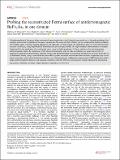Files in this item
Probing the reconstructed Fermi surface of antiferromagnetic BaFe2As2 in one domain
Item metadata
| dc.contributor.author | Watson, Matthew D. | |
| dc.contributor.author | Dudin, Pavel | |
| dc.contributor.author | Rhodes, Luke C. | |
| dc.contributor.author | Evtushinsky, Daniil V. | |
| dc.contributor.author | Iwasawa, Hideaki | |
| dc.contributor.author | Aswartham, Saicharan | |
| dc.contributor.author | Wurmehl, Sabine | |
| dc.contributor.author | Büchner, Bernd | |
| dc.contributor.author | Hoesch, Moritz | |
| dc.contributor.author | Kim, Timur K. | |
| dc.date.accessioned | 2019-08-09T10:30:03Z | |
| dc.date.available | 2019-08-09T10:30:03Z | |
| dc.date.issued | 2019-07-16 | |
| dc.identifier | 260484011 | |
| dc.identifier | 6022a9a8-5f11-4bca-88b2-4c11bbb3046e | |
| dc.identifier | 85069458858 | |
| dc.identifier | 000493554800001 | |
| dc.identifier.citation | Watson , M D , Dudin , P , Rhodes , L C , Evtushinsky , D V , Iwasawa , H , Aswartham , S , Wurmehl , S , Büchner , B , Hoesch , M & Kim , T K 2019 , ' Probing the reconstructed Fermi surface of antiferromagnetic BaFe 2 As 2 in one domain ' , npj Quantum Materials , vol. 4 , 36 . https://doi.org/10.1038/s41535-019-0174-z | en |
| dc.identifier.issn | 2397-4648 | |
| dc.identifier.other | ORCID: /0000-0003-2468-4059/work/60427705 | |
| dc.identifier.other | ORCID: /0000-0002-0737-2814/work/60427725 | |
| dc.identifier.uri | https://hdl.handle.net/10023/18283 | |
| dc.description | The work at IFW was supported by the Deutsche Forschungsgemeinschaft (DFG) through the Priority Programme SPP1458. L.C.R. is supported by an iCASE studentship of the UK Engineering and Physical Sciences Research Council (EPSRC) and Diamond Light Source Ltd CASE award. S.A. thanks the DFG for funding (AS 523/4-1 & 523/3-1). | en |
| dc.description.abstract | A fundamental part of the puzzle of unconventional superconductivity in the Fe-based superconductors is the understanding of the magnetic and nematic instabilities of the parent compounds. The issues of which of these can be considered the leading instability, and whether weak- or strong-coupling approaches are applicable, are both critical and contentious. Here, we revisit the electronic structure of BaFe2As2 using angle-resolved photoemission spectroscopy (ARPES). Our high-resolution measurements of samples “detwinned” by the application of a mechanical strain reveal a highly anisotropic 3D Fermi surface in the low-temperature antiferromagnetic phase. By comparison of the observed dispersions with ab initio calculations, we argue that overall it is magnetism, rather than orbital/nematic ordering, which is the dominant effect, reconstructing the electronic structure across the Fe 3d bandwidth. Finally, using a state-of-the-art nano-ARPES system, we reveal how the observed electronic dispersions vary in real space as the beam spot crosses domain boundaries in an unstrained sample, enabling the measurement of ARPES data from within single antiferromagnetic domains, and showing consistence with the effective mono-domain samples obtained by detwinning. | |
| dc.format.extent | 9 | |
| dc.format.extent | 1899361 | |
| dc.language.iso | eng | |
| dc.relation.ispartof | npj Quantum Materials | en |
| dc.subject | QC Physics | en |
| dc.subject | Electronic, Optical and Magnetic Materials | en |
| dc.subject | Condensed Matter Physics | en |
| dc.subject | NDAS | en |
| dc.subject | BDC | en |
| dc.subject.lcc | QC | en |
| dc.title | Probing the reconstructed Fermi surface of antiferromagnetic BaFe2As2 in one domain | en |
| dc.type | Journal article | en |
| dc.contributor.institution | University of St Andrews. Centre for Designer Quantum Materials | en |
| dc.contributor.institution | University of St Andrews. School of Physics and Astronomy | en |
| dc.identifier.doi | 10.1038/s41535-019-0174-z | |
| dc.description.status | Peer reviewed | en |
This item appears in the following Collection(s)
Items in the St Andrews Research Repository are protected by copyright, with all rights reserved, unless otherwise indicated.

